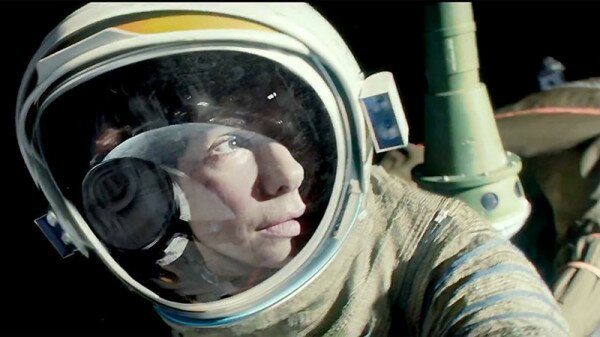
In what promises to be a new landmark, both in science fiction cinema and the craft of filmmaking itself, Alfonso Cuaron’s deep space survival thriller offers jaw dropping spectacle, nail-chewing suspense and an incredibly intimate character study, shot against the stunning backdrop of planet Earth itself.
A difficult filmmaker to pigeonhole, Alfonso Cuaron has accumulated an eclectic oeuvre to-date, moving with apparent ease from Spanish language efforts like Love in the Time of Hysteria and Y Tu Mama Tambien to revitalising the staid Harry Potter series with the tide-turning Prisoner of Azkaban, before tackling dystopian science-fiction in the criminally underseen Children of Men. Nominally staying in the same genre for his latest effort, Gravity could not be further removed from his 2010 Clive Owen vehicle, focusing on an intimate human drama of two stranded scientists – only to set the whole thing in space.
For the bulk of its running time, Gravity sees its protagonists (and only onscreen cast members) Dr. Ryan Stone (Sandra Bullock) and Lt. Matt Kowalski (George Clooney) floating weightless in Earth’s orbit, after fast-moving debris from an exploded satellite destroys their shuttle, essentially leaving them shipwrecked in the oceans of space. Running low on oxygen and facing further bombardment, the two astronauts are pushed to their physical, emotional and intellectual limits as they attempt to stay alive and find a way home.
Narratively, there’s little more to the film, which draws from the likes of Robinson Crusoe (and by extension Castaway) more liberally than its closest sci-fi cousins, Alien or 2001: A Space Odyssey. From a technical standpoint however, Gravity is a bravura display of trailblazing techniques, integrating computer effects with live performance – often in elaborate, lengthy single takes – that are breathtaking to behold. In Children of Men, Cuaron revealed his prowess for pushing the boundaries of camera agility and complex blocking in a series of then-unmatched tracking shots. In Gravity, however, he raises that bar well out of reach.
The film opens with a startlingly intricate single shot that must last a good 20 minutes, as we drift slowly towards Stone and Kowalski, hard at work during their routine space walk. The mood quickly changes as news of incoming debris escalates to a full-scale disaster that sees Stone catapulted far from Kowalski and the shuttle. Cuaron displays incredible restraint and pacing, slowly building towards the impending threat, while also showing a wonderful understanding of action through the depth of field of his frame. Although not shot in 3D, the director is keenly aware that the film would be viewed in this way, and ensures much of the action takes place along the z axis – from the rear to the front of the image.
However, even when Gravity removes its foot from the adrenalin pedal, if only to give its audience and skeleton cast a moment to breathe, the look of the film is staggering. Almost every scene is offset by the stunning backdrop of Earth, and Cuaron never wastes an opportunity to relish a Kubrickian sunrise or spectacular cloud formation, or simply to hold on a close-up of Bullock or Clooney as they take in the view for themselves.
Regular collaborator Emmanuel Lubezki, who has shot all of Cuaron’s films except Prisoner of Azkaban (as well as The Tree of Life and The New World for Terence Malick among many others) ensures the claustrophobic interiors of shuttle modules and escape pods are as vividly depicted as the vastness of the heavens that envelope them, while remaining mobile, urgent and adventurous in work that may well be rewarded come awards time. Add to this the incredible aural landscapes of Steven Price’s majestic, breathless score and Gravity seems to have all its technical bases covered.
But as is the case with all great works of drama, Gravity lives or dies with its performances, and George Clooney and particularly Sandra Bullock deliver impeccable work to match everyone else involved. Clooney can do “calm, charismatic and cool-headed in a crisis” seemingly in his sleep, but never feels like he is giving anything less than 100% here. But Gravity belongs to Sandra Bullock as much as it does to its pioneering director. She gives a powerfully nuanced performance in a role that wavers frequently from quivering fear to determined resolve as Dr. Ryan Stone finds herself all alone in the vastness of space on her very first trip off-world. She must run the gamut of emotions across the film’s refreshingly lean 90-minute run-time, and is often the only character onscreen. Bullock shows a confidence and versatility she is rarely afforded the opportunity to display, and will likely be a strong frontrunner in the awards race.
Critics in the scientific field have been quick to nit-pick over the inaccuracies of certain details, to which 99% of the film’s audience will be oblivious, and display a degree of pedantry that sound more like pleas for attention than genuine criticism. Elsewhere, some have cited the narrative simplicity and implausibility of the snowballing disasters that ensue, but simply put, that’s the film. If you’re not a fan of spectacular compounding peril, then admittedly Gravity may not be for you. What nobody has done, however, is take issue with the quality of its execution.
Gravity is total cinema. A technical masterclass that pushes the boundaries of event filmmaking, while showcasing a praiseworthy female performance in an effective story that pits human resilience against natural adversity. From its show-stopping visuals to its nerve shredding action, epic score and career-best performance from Sandra Bullock, you will be hard-pressed to find a more intimate, epic, beautiful or bombastic piece of entertainment all year.